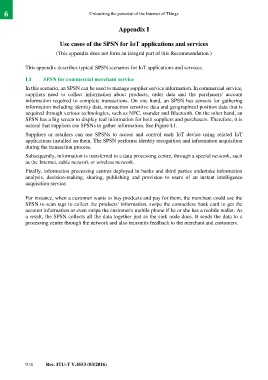Page 928 - Unleashing the potenti al of the Internet of Things
P. 928
6 Unleashing the potential of the Internet of Things
Appendix I
Use cases of the SPSN for IoT applications and services
(This appendix does not form an integral part of this Recommendation.)
This appendix describes typical SPSN scenarios for IoT applications and services.
I.1 SPSN for commercial merchant service
In this scenario, an SPSN can be used to manage supplier service information. In commercial service,
suppliers need to collect information about products, order data and the purchasers' account
information required to complete transactions. On one hand, an SPSN has sensors for gathering
information including identity data, transaction sensitive data and geographical position data that is
acquired through various technologies, such as NFC, sounder and Bluetooth. On the other hand, an
SPSN has a big screen to display real information for both suppliers and purchasers. Therefore, it is
natural that suppliers use SPSNs to gather information. See Figure I.1.
Suppliers or retailers can use SPSNs to access and control each IoT device using related IoT
applications installed on them. The SPSN performs identity recognition and information acquisition
during the transaction process.
Subsequently, information is transferred to a data processing centre, through a special network, such
as the Internet, cable network or wireless network.
Finally, information processing centres deployed in banks and third parties undertake information
analysis, decision-making, sharing, publishing and provision to users of an instant intelligence
acquisition service.
For instance, when a customer wants to buy products and pay for them, the merchant could use the
SPSN to scan tags to collect the products' information, swipe the contactless bank card to get the
account information or even swipe the customer's mobile phone if he or she has a mobile wallet. As
a result, the SPSN collects all the data together just as the sink node does. It sends the data to a
processing centre through the network and also transmits feedback to the merchant and customers.
914 Rec. ITU-T Y.4553 (03/2016)

